Applicants and students in higher vocational education 2019
Higher vocational education expanding rapidly
Statistical news from Statistics Sweden 2020-03-27 9.30
The number of applicants to higher vocational education increased significantly in 2019. There were 53 000 qualified applicants, which was an increase of 22 percent. Admitted students who commenced their studies also increased by 22 percent, to 28 100 admitted students. There were 63 200 students in higher vocational education in total.
In 2019, higher vocational education expanded its student capacity to 29 500 places, which corresponds to an increase of around 5 000 places from 2018.
The number of applicants to higher vocational education programmes that began in 2019 also increased sharply compared with the previous year. There were 70 700 applicants in total, 53 000 of whom were qualified. The upturn in the number of qualified applicants and in the number of places means that there were 1.8 qualified applicants per place, which is on level with 2018.
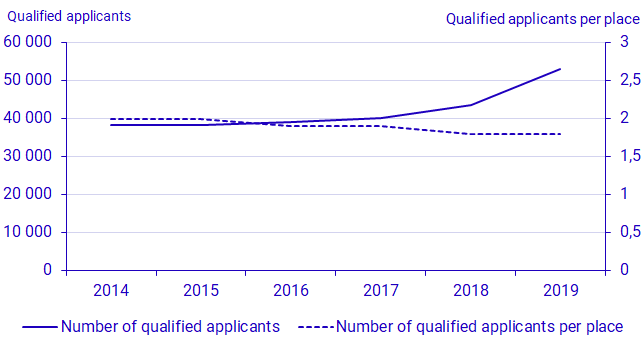
Women and men apply to different programmes
Women accounted for nearly three-fifths of the total number of applicants to higher vocational education in 2019. Among the applicants to higher vocational education programmes, 41 200 were women and 29 400 were men, of whom 31 700 and 21 300 were qualified, respectively.
Qualified applicants’ choices of fields of education differed based on applicants’ sex. Women comprise a large majority of the applicants to programmes in Health and medical care and social services. Women also dominated programmes in Fitness and wellness and Law among the applications. Men to a greater extent than women applied to programmes in Technology and manufacturing and Computers/IT.
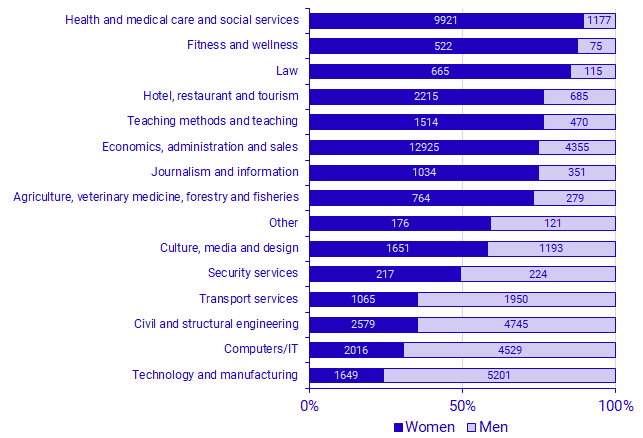
Application popularity varies by county
The number of qualified applicants per place varied between the counties in which the programmes are held. The number of qualified applicants per place was highest in Gävleborg County. The number of applications was also relatively high to programmes in Östergötland County and Västmanland County. Kalmar County noted the lowest number of applicants per place in Sweden.
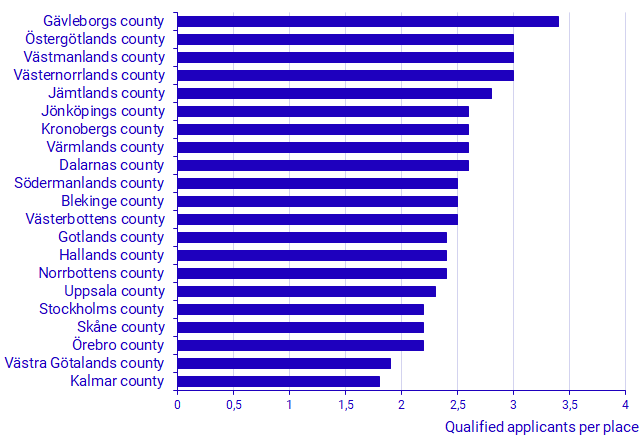
More women than men began studies, but share of men increasing
There were 28 100 admitted students who commenced their studies in 2019, up by 22 percent from 2018. There were 12 700 men who commenced their studies, up by 25 percent, and 15 300 women, up by 20 percent. The share of women, which has been larger than the share of men over time, amounted to 55 percent.
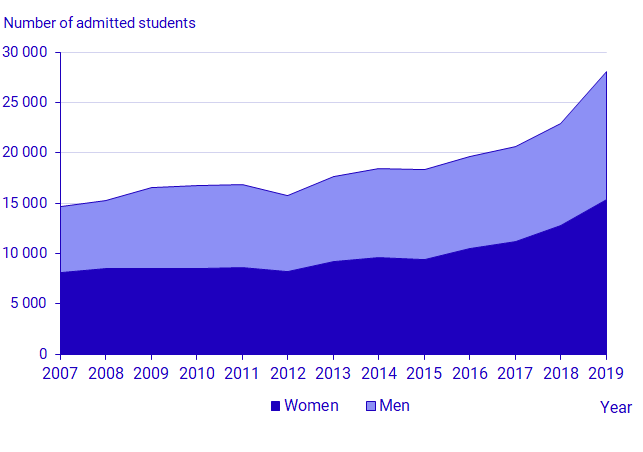
Major differences between the sexes in different fields of education
Economics, administration and sales had the highest number of admitted students who commenced their studies, with 6 500 admitted students. Women accounted for 74 percent of those who commenced their studies. This was followed by Health and medical care and social services, with 4 200 admitted students, 91 percent of whom were women.
Civil and structural engineering and Computers/IT admitted 3 900 students each. Students in this field were predominantly men, who accounted for around 70 percent. In Technology and manufacturing, there were 3 800 admitted students who commenced their studies, and men accounted for 79 percent.
The largest increase was in Computers/IT, 52 percent; the share of women increased the most, 75 percent, compared with the share of men at 45 percent. Transport services also increased significantly, by 42 percent, and was relatively evenly distributed between women and men.
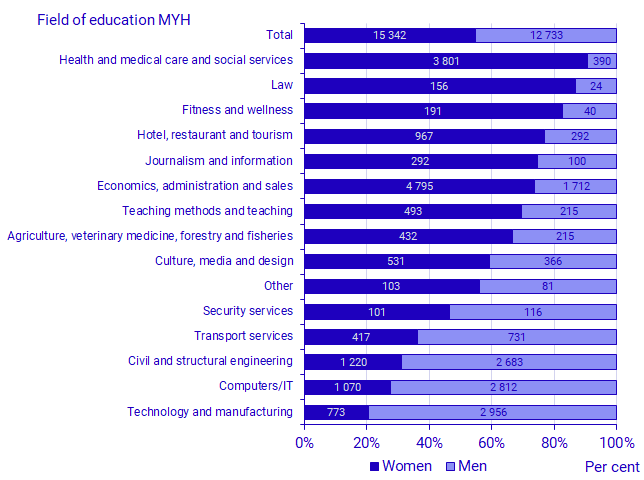
More students in distance learning
The share of admitted students in distance learning programmes increased from 24 percent to 27 percent. In total, 7 500 students were admitted to distance learning programmes, compared with 20 600 students in traditional programmes.
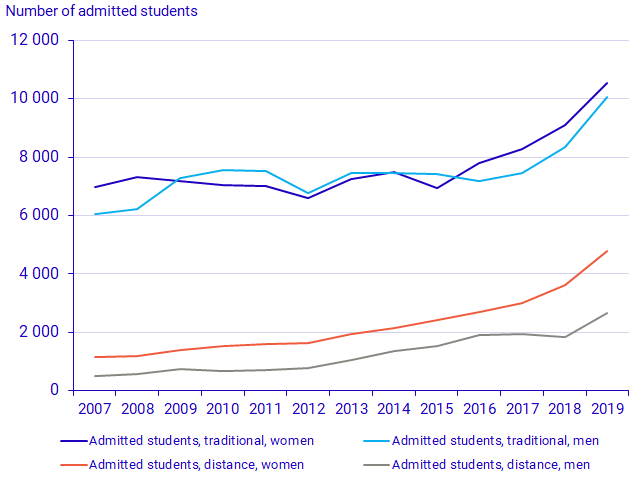
Women attended distance education to a higher degree than men. Among women, 31 percent attended distance education. The corresponding figure among men was 21 percent.
The form of study varied between fields of education. The highest share of distance learning was in Health and medical care and social services (56 percent) and in Teaching methods and teaching (51 percent).
Share of students with foreign background increased
In 2019, the share of admitted students with foreign background increased from 30 percent to 32 percent. There were more men with foreign background (4 600) than women with foreign background (4 300). The share of women with Swedish background accounted for 39 percent (11 000) of all admitted women who commenced their studies. The corresponding figure for men was 29 percent (8 200).
More than 63 200 students now
In 2019, there were 63 200 students in higher vocational education. For several years, the five largest fields of education have accounted for around 80 percent of all students. Economics, administration and sales accounted for the largest number of students, 15 600, which corresponds to 25 percent of all students.
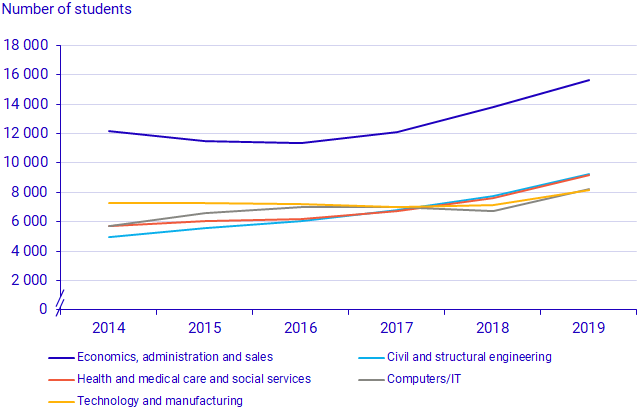
Among other fields of education, Teaching methods and teaching noted a large increase of 53 percent, and the number of students amounted to 1 300. Transport services increased by 13 percent, and had 2 300 students.
Among the students, 55 percent were women (34 700) and 45 percent were men (28 500).
Definitions and explanations
Official statistics on higher vocational education
Since 2018, Statistics Sweden has been responsible for official statistics on higher vocational education.
Statistics on applicants to higher vocational education are based on data that Statistics Sweden has collected from education providers since 2014. In the period 2014-2017, Statistics Sweden collected the survey data on behalf of the National Agency for Higher Vocational Education.
Statistics on students in higher vocational education are based on information from the Swedish National Agency for Higher Vocational Education, which in turn receives the information from the education providers. Higher vocational education is included in the statistics for 2007-2013.
Applicants
An applicant is defined by the following criteria:
- The applicant has submitted an application that includes information about the applicant’s name and personal identity number (or name and date of birth).
- The applicant has submitted their application within the application period (within the ordinary or extended application period).
Net statistics of the number of applicants and the number of qualified applicants are presented. This means that once the number of applicants is reported, grouped by various education data, such as field of education or county, the number of unique applicants per study domain is counted. Persons who have applied to several study programmes in different study domains are counted once in each domain.
Admitted students who commenced their studies
The number of admitted students who commenced their studies refers to the number of persons studying three weeks after the study session began. Students who have been added during the course of the education and those who have dropped out are included. This means that all those who have been included in at least one register of students in a programme session are included.
Students
The number of students refers to active students in programme sessions that last at least one day during a specific period. An active student must be included in at least one study register during a specific period.
Persons who have been active students in several programmes during a specific period are counted once for each programme session. In 2018, around 300 persons commenced their studies in more than one programme session.
Field of education
Field of education refers to the classification of programmes in the fields of education used by the Swedish National Agency for Higher Vocational Education (MYH). The fields of education are based on the SUN 2000 standard.
Next publishing will be
Statistics on graduates in 2019 are scheduled for publication in November 2020 together with updated information on applicants and students.
Statistical Database
More information is available in the Statistical Database
Feel free to use the facts from this statistical news but remember to state Source: Statistics Sweden.
